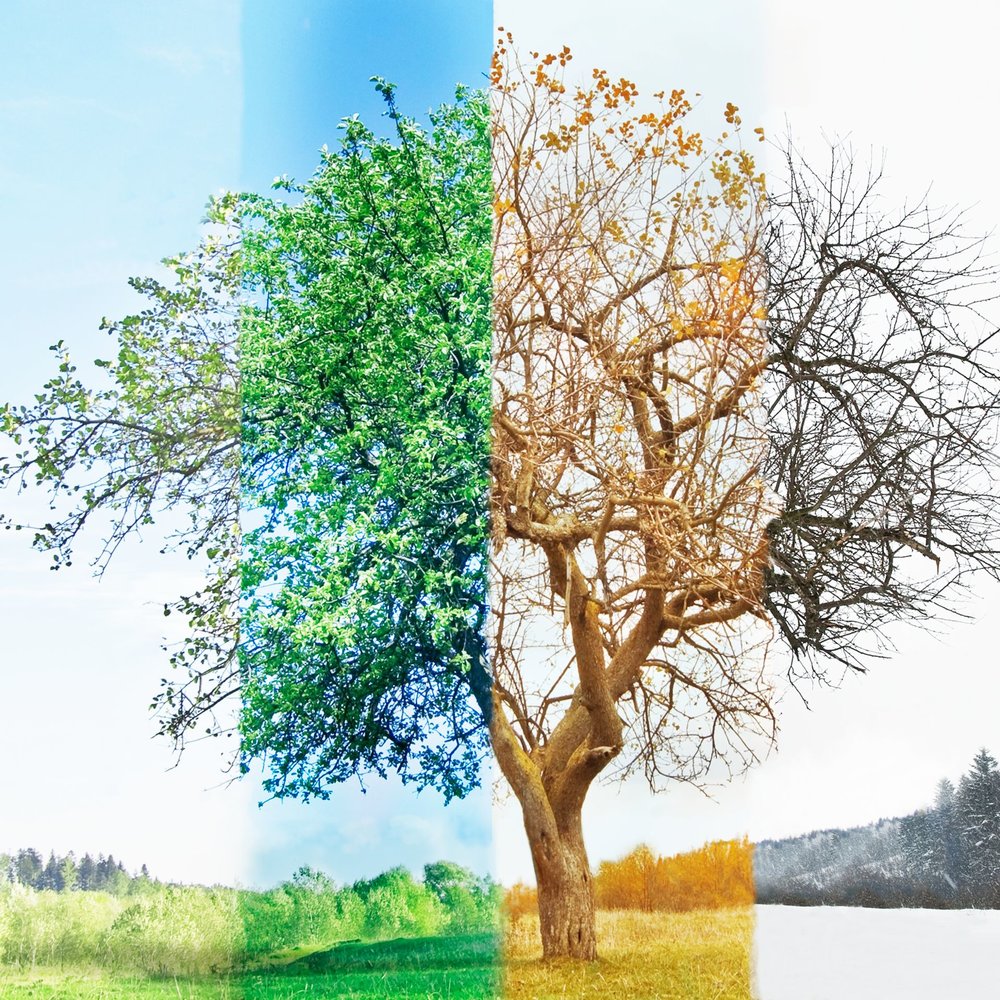THE SEASONS OF GRIEF
January 4, 2021
Public Information Evening
James Reid Funeral Home
Nancy Hancock
I know that each one of you has come tonight because you are mourning the
loss of a loved one. How you cope with that death and loss is very personal. Some people go inward and prefer not to talk with others about their grief. Others find solace in sharing their grief with any and all who will listen. There is no right or wrong way to grieve a death of someone whom you loved. And of course, grieving is altogether different in the time of Covid 19. The traditional ways of providing comfort and support to those who are grieving are not possible.
How has grief been different for you, during the pandemic?
Were you able to have the gathering you hoped for?
-visitation by zoom or driveby
- limited attendance at services or no service
- livestreamed service
- no reception afterwards
-no home visits or bringing food to the bereaved
Many experts in the subject of grief have sought to explain grief in terms of
stages. The grief process is quantified as a series of stages that most people go through. While some find that model helpful, it may also be very limiting. For one thing, people don’t always go through the various stages in order, nor do they even go through some of the prescribed stages.
Then there is a model of grief being like a journey, with tasks to complete. Its limitation is that it implies that there is a destination, an ending to grief that one can arrive at. You may have found that grief never really ends; it changes over time or we learn to adjust our reactions to grief. Grief changes US, rather than grief coming to an end.
There are many other models of grief. Just google “models of grief” and you
will find a variety of them.
There is a different model of the grief process which has been written about
by some authors, which we are going to highlight tonight, called The Seasons of Grief model. Monique Cerundolo’s book called Seasons of Grief and Hope, provides a reflection on grief which is based on the natural cycles of the seasons. In her book, the entry to one’s grief is likened to the season of winter. James E. Miller, in his books and videos on the Seasons of Grief, some of which we have in our lending library, envisions the beginning of grief as the season of autumn.
As we go through grief in each season, think about which season your
grief began in, not literally, but metaphorically.
While there are many different theories about the path of grief, no one more
right than another, it is important to note that grief is a natural, normal, and
instinctive way of healing. It is the price of loving someone, as the saying goes. It has a purpose: to help us return to living and to find meaning and purpose once again. And grief finds its way into every season of life. James Miller writes,
“Grieving is as natural as nature itself: as natural as summer being cropped by
autumn, autumn slipping away into winter, and winter awakening into spring, and spring blossoming into summer again”.
We in Canada are blessed with four distinct seasons of the year, which make the Seasons of Grief a metaphor which is easy to relate to. Since we are at the beginning of a long, Canadian winter, we are going to begin to explore and share the experience of grief in winter.
SEASON OF WINTER
Winter is for most of us in the northern hemisphere the most difficult season
of the year. Someone once said, “I used to love the winter; feeling warm and safe while the snow fell outside. I also used to love those chilly walks down by the lake. Since my husband died, I have little interest in either.”
What is the season of winter like in Canada?
- long, never-ending months
- dark days and long nights
- isolating: extreme weather keeps us indoors and away from people
- bone-chilling cold
When someone you loved has died, you might feel like you are thrust into a winterlike season of grief. The isolation of Covid magnifies that. Let’s think some more about winter:
How do we Canadians get through the winter?
- stay indoors and hibernate, or
- EMBRACE it! Winter sports – skating, skiing are “safe” to do now.
- cocoon
- layers of warm clothes and blankets
- put the fireplace on
- comfort food
- hot drinks
- see the beauty in the pure white snow
-l onging for spring
What physical symptoms do you experience in early grief which are a bit like
symptoms you feel in the winter?
- shivering with the “shock” of the news
- difficulty “catching your breath”
- exhaustion; need for sleep
- wanting to isolate within your residence
- comfort eating
- heaviness
- longing for it to be over
What can we do in the winter of our grief?
- sometimes just grin and bear it
- “lean into” grief: allow yourself to submit to grief’s work
- go inward, allow loneliness up to a point
- get outside every day—either to walk or do an errand. Lemoine’s Pt. is lovely
in the winter, quiet, able to see through the trees, new-fallen snow
- take this opportunity to pause, attend to the silence, be aware of feelings,
allow the silence to speak to you and JUST BE
- get lots of sleep
- cling to hope that “this too shall pass”
- join a group for support via zoom etc.: this one is monthly, BFO has many
groups
- call your Dr. to check in, even if virtually, if symptoms are severe
How does the winter season, especially this one, mirror your grief, physically and emotionally?
THE SEASON OF SPRING
What signals to you that Spring is on its way?
- snowdrops and crocuses appear through the remnants of snow—first sign!
- daylight hours are longer
- gradually warmer
- pale green buds on trees; then vibrant colours
- rain
- unpredictable weather
What might the “springtime” of your grief look like to you?
- brief feelings of relief from intense grief
- mood is lighter and brighter
- less withdrawn from people: being outside more
- the warmth outside feels warmer inside ourselves too
- can see COLOURS again!
- hints of new life and hope within
- times of warmth will revert to sudden stabs of chill: you still feel sad at times,
and be caught off-guard by a fresh stab of grief—this is normal as you move
through grief
- physically, GI issues can be unexpected and undependable
What can we do to move through grief during the season of Spring?
- experience the joy and sorrow, sometimes simultaneously
- let your feelings evolve naturally, don’t try to force yourself to feel a certain way
- become more involved in life—physically and emotionally
- experiment with new activities, biking or hiking; art; or plan a trip for when you will be able to travel again
- trust that you WILL survive your grief
- make a choice to slowly be more involved in life
- create a living memorial to your loved one: plant a vegetable garden, rose bush or tree--working the soil and weeding can be good for the soul
THE SEASON OF SUMMER
What do you enjoy most about the summer?
- long days, short nights
- being outside more; outdoor visits and bbqs (hopefully)
- lightness of no more boots and coats
- being more active and social
- mature plants; ripe fruits and vegetables, flowers in full bloom
What do you enjoy the least in summer?
- extreme heat and humidity
- difficulty sleeping
- added outdoor chores
- endless weeds
- sunburns and bug bites
How does your experience of summer mirror your grief experience?
- a respite from the reality of grief
- maturing and harvesting of the inner work you have accomplished
- feeling that you can weather the storms that will come
- more feelings of joy and hope for the future
- may still need protection from the sting of loss
- physically: trouble sleeping, sweating
THE SEASON OF AUTUMN
What signals to you the end of summer and the beginning of fall?
- shorter days, longer nights
- cooler temps, more rain, sometimes brilliant sun
- harvest of fruits and vegetables
- changing colour of leaves—brilliant colour; progressing to letting go; then falling to ground
- some stubborn leaves remain on the tree all winter
- plants dying
What do the signs of autumn remind you of in regards to your grief?
- what was vibrant, warm, and green is changing to darkness
- we want to cling to what was, to hold onto the person who has died
- difficulty letting go—what does the future hold for me now?
- symptoms of grief: depression or SAD; physical heartache; loneliness
In every season, there are signs of what is to come. What signs of hope do you
see in the autumn?
- we KNOW that the leaves are going to return in the spring and dead plants
will bloom again
- beautiful colours of nature even in the midst of dying and letting go
- planting bulbs in the fall—look forward to their blooming in spring!
What things can we do in the autumn stage of our grief, which we learn from the season?
- acknowledge your feelings of sadness
- trust in the process: grief will change and usually becomes easier
- allow yourself to take pleasure in the beauty of autumn
- when it gets dark early, turn on the lights, light the candles, put on the fireplace
- plant tulip or daffodil bulbs in hope of warmer days.
- “put the garden to bed”—what does this mean for the gardeners? For us?
(take out the dead plants, add fertilizer, protect delicate plants)
There are rich metaphors for us to learn from the season of autumn!
A very wise person wrote these familiar words which are in the Bible in
Ecclesiastes 3:
To everything there is a season, and a time for every purpose under the
heaven. A time to be born and a time to die; a time to plant and a time to pluck up that which is planted.
How can we encourage growth in our grief?
- recognize and celebrate small victories
- share your experience of grief with someone else who is going through it
- welcome the changes you notice in your grief
- when a fresh wave of grief hits, as it will, allow it to wash over you, knowing that “this too shall pass”, just as the seasons do
- nurture an attitude of gratitude for all of life
- learn to accept the reality of death and to embrace the things that death cannot take away: the love you shared, the memories you hold, and the meaning of your loved one’s life. These things remain forever
- be thankful for all you shared with your person
What season of your grief do you feel that you are in now?
Winter? Spring? Summer? or Fall?
Is there anything in the season you are in which gives you a sign of hope?
Jill Kottmeier wrote a letter in which she imagines her person writing these
words to her:
With the change of every season, think of me and find a way to honour
my spirit. As the spring showers start falling, the birds start singing, and
the magnolia trees start blooming, take a moment to take it all in and
appreciate the beauty. During the summer, enjoy the warmth of the
sun on your face, the flowers, the fresh cut grass, the insanely
beautiful summer storms and rainbows. I will be in each of these
things. As fall begins to come around the corner…enjoy the crisp
air, and as you watch the leaves fall from the trees, realize that
this death will soon give way to a rebirth to life. When the snow
starts falling for the first time, go outside and let the snowflakes
fall on your tongue, and enjoy each moment.
From a Poem by William Wordsworth:
Though nothing can bring back the hour
of splendour in the grass, of glory in the flower,
we will grieve not, rather find
strength in what remains behind.
Seasons pass. As you journey through your grief, may your seasons be light.
BIBLIOGRAPHY
Seasons of Grief and Hope. Monique Cerundolo.
2013 by CreateSpace Independent Publishing Platform.
Winter Grief, Summer Grace: Returning to Life After a Loved One Dies.
James E. Miller.
1995 by Augsburg Books.
website resource: https://elainemansfield.com/2014/nature-seasons-grief-hope/
When I’m Gone (a letter). Jill Kottmeier. Bereaved Families of Ontario Kingston
Region Newsletter, March 2019.






Comments